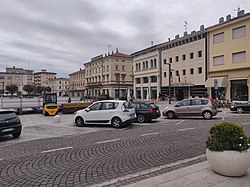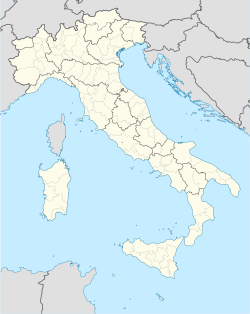Top Qs
Timeline
Chat
Perspective
Monfalcone
Comune in Friuli-Venezia Giulia, Italy From Wikipedia, the free encyclopedia
Remove ads
Monfalcone (Italian pronunciation: [moɱfalˈkoːne]; Bisiacco: Mofalcòn; Friulian: Monfalcon; Slovene: Tržič; archaic German: Falkenberg) is a town and comune (municipality) in the Regional decentralization entity of Gorizia in Friuli-Venezia Giulia, northern Italy, located on the Gulf of Trieste. Its name means 'falcon mountain' (see Montfaucon in French and Falkenberg in Germanic languages).
It is a major industrial centre for manufacturing ships, airplanes, textiles, chemicals, and refined oil, and is home to one of Fincantieri's main shipyards. Monfalcone is the northernmost city on the Mediterranean Sea.
Remove ads
Geography

Monfalcone is the fifth most populous town in Friuli-Venezia Giulia and the main centre of Bisiacaria territory. Joined to its neighbourhoods, it has about 50,000 inhabitants. The town lies between the Karst hills and the Adriatic coast, and it is the northernmost port of the Mediterranean Sea.
The municipality extends along the northern coastal strip of the Adriatic Sea for 24.39 km and is enclosed to the south by the bay of Panzano and to the north-east by the Carso, while to the north-west it borders the municipalities of Ronchi dei Legionari and Staranzano.[3] From a seismic point of view, the municipal territory is located, according to the Civil Protection classification, in zone 3 subject to low seismicity.[4]
Remove ads
Climate
Remove ads
History
Summarize
Perspective
In prehistoric times the area of Monfalcone housed several fortified villages called castellieri. After the foundation of the Roman city of Aquileia (181 BC), some thermal buildings were created on the hills, known as Insulae Clarae.
After Ostrogoth, Byzantine, Lombard, and Frankish domination, Monfalcone was controlled by the Patriarchs of Aquileia starting from 967.[6] The Venetians conquered it in 1420 after three days of siege, keeping it until 1511, when it fell to the French. Conquered back by Venice, it was ravaged by the troops of Habsburg Emperor Maximilian I in 1513, who destroyed the Rocca fortress. In 1521 it was returned to the Republic of Venice, under which it remained until its dissolution by the 1797 Treaty of Campo Formio.

From 1805 it was controlled by the French Empire until the fall of Napoleon in 1814, after which it was included in the Kingdom of Illyria, part of the Austrian Empire. Incorporated into the crown land of Gorizia and Gradisca, it belonged to the Austrian Littoral from 1849. The first shipyards arose from about 1908 onwards, among them the Cantiere Navale Triestino company building steamships for the Austro-Americana Line based in Trieste. During World War I, the town was captured by Italian forces in 1915 and became the rear line during the bloody Battles of the Isonzo, being briefly recaptured by Austria-Hungary after the 1917 Battle of Caporetto, but returning to Italy in 1918. The shipyards were severely damaged by bitter fighting and had to be rebuilt afterwards. During World War II the town was repeatedly bombed and heavily damaged, became a center of the Italian Resistance after the Armistice of Cassibile, and it was briefly occupied by Yugoslav troops at the end of the war.
Society
Demographic evolution

Foreign ethnicities and minorities
As of December 31, 2024, foreigners residents in the municipality were 9,991, i.e. 32.0% of the population.[7] The largest foreign community is that from Bangladesh with 55.0% of all foreigners present in the city, followed by Romania and North Macedonia.[8]
Main sights
- Rocca fortress. Of medieval origin (according to a legend, it was founded by Theoderic the Great, King of the Ostrogoths), its current appearance dates to Venetian restorations in the early 16th century. The interior houses a speleology exhibition.
- World War I Open air museum
- Karst area
- Saint Ambrose's Cathedral
- Roman villas and thermae: Several remains of Roman villas have been found on the territory of the municipality of Monfalcone. The sites are object of archaeological research but are not open to public. A thermae dating back to the Roman era is also present and what remains of the ancient edifice is now included in the current thermal establishment that was reactivated in 2014.[9]
Remove ads
Transport
Monfalcone is served by regionally and nationally important roads, spanning a total of nearly 100 km.[10] The S.S. 14 of Venezia Giulia and the A4 highway pass through the city, allowing access to the toll booths.
- Monfalcone West - Redipuglia
- Monfalcone East - Trieste Lisert[11]
Monfalcone railway station, opened in 1860, is a junction between the Venice–Trieste railway and the Udine–Trieste railway.
The construction and design records of the ships produced in Monfalcone Shipyard Number 1 from 1909 - 1967 have been preserved in the Fondo Egone Missio Archives (Egone Missio Archives).
Monfalcone is home to the northernmost commercial port in the Adriatic, the Mediterranean and Italy, making it the second largest regional port and the hub for unloading goods destined for all of Europe. The Port of Monfalcone is thus a highly diverse port, with a de facto specialization in the automotive market, whose traffic is rapidly growing. It operates in close synergy with the Port of Trieste, both being part of the Eastern Adriatic Port System Authority.[12]
Remove ads
People
- Enrico Toti (1882–1916), cyclist, was killed in the Sixth Battle of the Isonzo in Monfalcone
- Antonio Sant'Elia (1888–1916), architect, was killed in the Eighth Battle of the Isonzo in Monfalcone
- Filippo Zappata (1894–1994), engineer, worked in Monfalcone
- Mirko Gruden (1911–1967), footballer
- Gino Paoli (born 1934), singer-songwriter
- Paolo Rossi (born 1953), actor
- Stefano Zoff (born 1966), boxer
- Mo-Do (Fabio Frittelli; 1966–2013), musician
- Elisa Toffoli (born 1977), singer-songwriter, grew up in Monfalcone
- Massimiliano Versace (born 1972), scientist
Remove ads
International relations
Monfalcone is twinned with:
 Neumarkt in Steiermark, Austria
Neumarkt in Steiermark, Austria Gallipoli, Italy
Gallipoli, Italy Karadeniz Ereğli, Turkey
Karadeniz Ereğli, Turkey Zonguldak, Turkey
Zonguldak, Turkey
Trivia
In 2024 religious, cultural and ethnic factors gained importance with cricket being banned in the town.[13]
References
External links
Wikiwand - on
Seamless Wikipedia browsing. On steroids.
Remove ads




